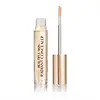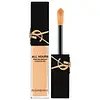Charlotte Tilbury Beautiful Skin Radiant Concealer Versus Yves Saint Laurent All Hours Precise Angles Concealer
What's inside
What's inside
 Key Ingredients
Key Ingredients

 Benefits
Benefits

 Concerns
Concerns

 Ingredients Side-by-side
Ingredients Side-by-side

Water
Skin ConditioningDicaprylyl Ether
EmollientPolyglyceryl-3 Polyricinoleate
EmulsifyingGlycerin
HumectantCoco-Caprylate/Caprate
EmollientPolyglyceryl-3 Diisostearate
EmulsifyingNiacinamide
SmoothingMica
Cosmetic ColorantHydrogenated Castor Oil
EmollientAcacia Decurrens/Jojoba/Sunflower Seed Wax Polyglyceryl-3 Esters
EmollientCollagen
MoisturisingMagnesium Sulfate
Silica
AbrasiveLauroyl Lysine
Skin ConditioningAluminum Hydroxide
EmollientSqualane
EmollientLevulinic Acid
PerfumingSodium Dehydroacetate
PreservativeSodium Levulinate
Skin ConditioningTocopherol
AntioxidantSodium Lauroyl Glutamate
Camellia Japonica Seed Oil
EmollientHydrolyzed Sodium Hyaluronate
Skin ConditioningHelianthus Annuus Seed Oil
EmollientLysine
Skin ConditioningParfum
MaskingMagnesium Chloride
Sorbitol
HumectantPropanediol
SolventCaprylic/Capric Triglyceride
MaskingCetyl Palmitate
Emollient1,2-Hexanediol
Skin ConditioningCaprylyl Glycol
EmollientPolysorbate 80
EmulsifyingSorbitan Stearate
EmulsifyingXanthan Gum
EmulsifyingSodium Benzoate
MaskingCitric Acid
BufferingHydrogenated Lecithin
EmulsifyingAscorbic Acid
AntioxidantColloidal Gold
AntimicrobialGlutathione
Palmitoyl Tetrapeptide-10
Skin ConditioningCI 77891
Cosmetic ColorantIron Oxides
Water, Dicaprylyl Ether, Polyglyceryl-3 Polyricinoleate, Glycerin, Coco-Caprylate/Caprate, Polyglyceryl-3 Diisostearate, Niacinamide, Mica, Hydrogenated Castor Oil, Acacia Decurrens/Jojoba/Sunflower Seed Wax Polyglyceryl-3 Esters, Collagen, Magnesium Sulfate, Silica, Lauroyl Lysine, Aluminum Hydroxide, Squalane, Levulinic Acid, Sodium Dehydroacetate, Sodium Levulinate, Tocopherol, Sodium Lauroyl Glutamate, Camellia Japonica Seed Oil, Hydrolyzed Sodium Hyaluronate, Helianthus Annuus Seed Oil, Lysine, Parfum, Magnesium Chloride, Sorbitol, Propanediol, Caprylic/Capric Triglyceride, Cetyl Palmitate, 1,2-Hexanediol, Caprylyl Glycol, Polysorbate 80, Sorbitan Stearate, Xanthan Gum, Sodium Benzoate, Citric Acid, Hydrogenated Lecithin, Ascorbic Acid, Colloidal Gold, Glutathione, Palmitoyl Tetrapeptide-10, CI 77891, Iron Oxides
Water
Skin ConditioningDimethicone
EmollientIsododecane
EmollientGlycerin
HumectantPEG-9 Polydimethylsiloxyethyl Dimethicone
EmulsifyingPropylene Glycol
HumectantDisteardimonium Hectorite
StabilisingSilica
AbrasiveDimethicone Crosspolymer
Emulsion StabilisingPEG-10 Dimethicone
Skin ConditioningCetyl PEG/PPG-10/1 Dimethicone
EmulsifyingSodium Chloride
MaskingPhenoxyethanol
PreservativePolyglyceryl-4 Isostearate
EmulsifyingCaprylyl Glycol
EmollientDisodium Stearoyl Glutamate
CleansingEthylhexylglycerin
Skin ConditioningCaffeine
Skin ConditioningCoffea Arabica Seed Oil
MaskingAluminum Hydroxide
EmollientSteareth-20
CleansingJasminum Officinale Flower Extract
MaskingChlorhexidine Digluconate
AntimicrobialN-Hydroxysuccinimide
Skin ConditioningTocopherol
AntioxidantSodium Citrate
BufferingPotassium Sorbate
PreservativePalmitoyl Tripeptide-1
Skin ConditioningChrysin
Skin ConditioningPentaerythrityl Tetra-Di-T-Butyl Hydroxyhydrocinnamate
AntioxidantPalmitoyl Tetrapeptide-7
Skin ConditioningCitric Acid
BufferingBiotin
AntiseborrhoeicWater, Dimethicone, Isododecane, Glycerin, PEG-9 Polydimethylsiloxyethyl Dimethicone, Propylene Glycol, Disteardimonium Hectorite, Silica, Dimethicone Crosspolymer, PEG-10 Dimethicone, Cetyl PEG/PPG-10/1 Dimethicone, Sodium Chloride, Phenoxyethanol, Polyglyceryl-4 Isostearate, Caprylyl Glycol, Disodium Stearoyl Glutamate, Ethylhexylglycerin, Caffeine, Coffea Arabica Seed Oil, Aluminum Hydroxide, Steareth-20, Jasminum Officinale Flower Extract, Chlorhexidine Digluconate, N-Hydroxysuccinimide, Tocopherol, Sodium Citrate, Potassium Sorbate, Palmitoyl Tripeptide-1, Chrysin, Pentaerythrityl Tetra-Di-T-Butyl Hydroxyhydrocinnamate, Palmitoyl Tetrapeptide-7, Citric Acid, Biotin
Ingredients Explained
These ingredients are found in both products.
Ingredients higher up in an ingredient list are typically present in a larger amount.
Aluminum Hydroxide is a form of aluminum. It can be naturally found in nature as the mineral gibbsite. In cosmetics, Aluminum Hydroxide is used as a colorant, pH adjuster, and absorbent.
As a colorant, Aluminum Hydroxide may add opacity, or reduce the transparency. Aluminum hydroxide is contains both basic and acidic properties.
According to manufacturers, this ingredient is an emollient and humectant. This means it helps hydrate the skin.
In medicine, this ingredient is used to help relieve heartburn and help heal ulcers.
There is currently no credible scientific evidence linking aluminum hydroxide in cosmetics to increased cancer risk.
Major health organizations allow the use of aluminum hydroxide in personal care products and have not flagged it as a carcinogenic risk at typical usage levels.
Learn more about Aluminum HydroxideCaprylyl Glycol is a humectant and emollient, meaning it attracts and preserves moisture.
It is a common ingredient in many products, especially those designed to hydrate skin. The primary benefits are retaining moisture, skin softening, and promoting a healthy skin barrier.
Though Caprylyl Glycol is an alcohol derived from fatty acids, it is not the kind that can dry out skin.
This ingredient is also used as a preservative to extend the life of products. It has slight antimicrobial properties.
Learn more about Caprylyl GlycolCitric Acid is an alpha hydroxy acid (AHA) naturally found in citrus fruits like oranges, lemons, and limes.
Like other AHAs, citric acid can exfoliate skin by breaking down the bonds that hold dead skin cells together. This helps reveal smoother and brighter skin underneath.
However, this exfoliating effect only happens at high concentrations (20%) which can be hard to find in cosmetic products.
Due to this, citric acid is usually included in small amounts as a pH adjuster. This helps keep products slightly more acidic and compatible with skin's natural pH.
In skincare formulas, citric acid can:
While it can provide some skin benefits, research shows lactic acid and glycolic acid are generally more effective and less irritating exfoliants.
Most citric acid used in skincare today is made by fermenting sugars (usually from molasses). This synthetic version is identical to the natural citrus form but easier to stabilize and use in formulations.
Read more about some other popular AHA's here:
Learn more about Citric AcidGlycerin is already naturally found in your skin. It helps moisturize and protect your skin.
A study from 2016 found glycerin to be more effective as a humectant than AHAs and hyaluronic acid.
As a humectant, it helps the skin stay hydrated by pulling moisture to your skin. The low molecular weight of glycerin allows it to pull moisture into the deeper layers of your skin.
Hydrated skin improves your skin barrier; Your skin barrier helps protect against irritants and bacteria.
Glycerin has also been found to have antimicrobial and antiviral properties. Due to these properties, glycerin is often used in wound and burn treatments.
In cosmetics, glycerin is usually derived from plants such as soybean or palm. However, it can also be sourced from animals, such as tallow or animal fat.
This ingredient is organic, colorless, odorless, and non-toxic.
Glycerin is the name for this ingredient in American English. British English uses Glycerol/Glycerine.
Learn more about GlycerinSilica, also known as silicon dioxide, is a naturally occurring mineral. It is used as a fine, spherical, and porous powder in cosmetics.
Though it has exfoliant properties, the function of silica varies depending on the product.
The unique structure of silica enhances the spreadability and adds smoothness, making it a great texture enhancer.
It is also used as an active carrier, emulsifier, and mattifier due to its ability to absorb excess oil.
In some products, tiny microneedles called spicules are made from silica or hydrolyzed sponge. When you rub them in, they lightly polish away dead skin layers and enhance the penetration of active ingredients.
Learn more about SilicaTocopherol (also known as Vitamin E) is a common antioxidant used to help protect the skin from free-radicals and strengthen the skin barrier. It's also fat soluble - this means our skin is great at absorbing it.
Vitamin E also helps keep your natural skin lipids healthy. Your lipid skin barrier naturally consists of lipids, ceramides, and fatty acids. Vitamin E offers extra protection for your skin’s lipid barrier, keeping your skin healthy and nourished.
Another benefit is a bit of UV protection. Vitamin E helps reduce the damage caused by UVB rays. (It should not replace your sunscreen). Combining it with Vitamin C can decrease sunburned cells and hyperpigmentation after UV exposure.
You might have noticed Vitamin E + C often paired together. This is because it is great at stabilizing Vitamin C. Using the two together helps increase the effectiveness of both ingredients.
There are often claims that Vitamin E can reduce/prevent scarring, but these claims haven't been confirmed by scientific research.
Learn more about TocopherolWater. It's the most common cosmetic ingredient of all. You'll usually see it at the top of ingredient lists, meaning that it makes up the largest part of the product.
So why is it so popular? Water most often acts as a solvent - this means that it helps dissolve other ingredients into the formulation.
You'll also recognize water as that liquid we all need to stay alive. If you see this, drink a glass of water. Stay hydrated!
Learn more about Water